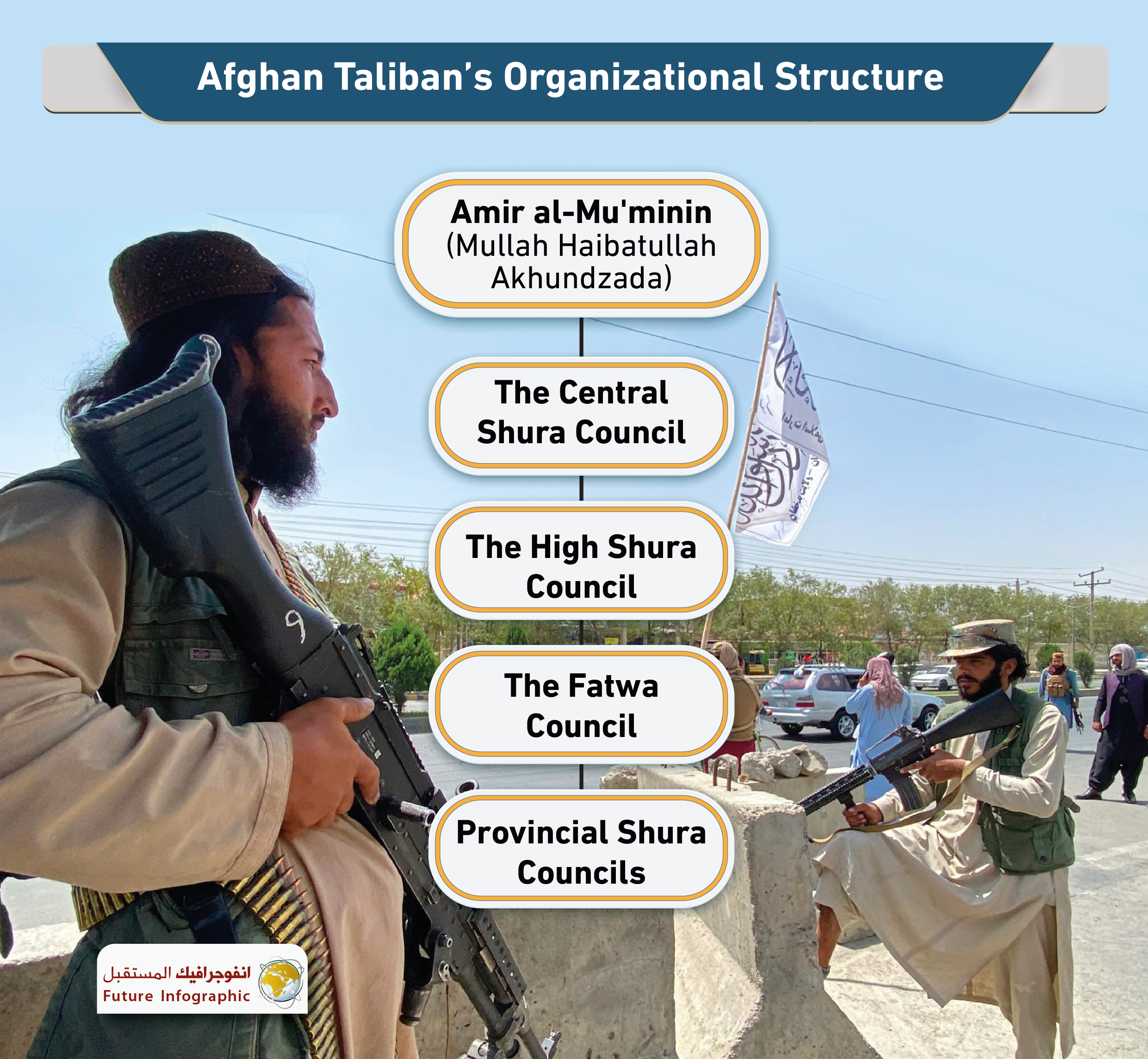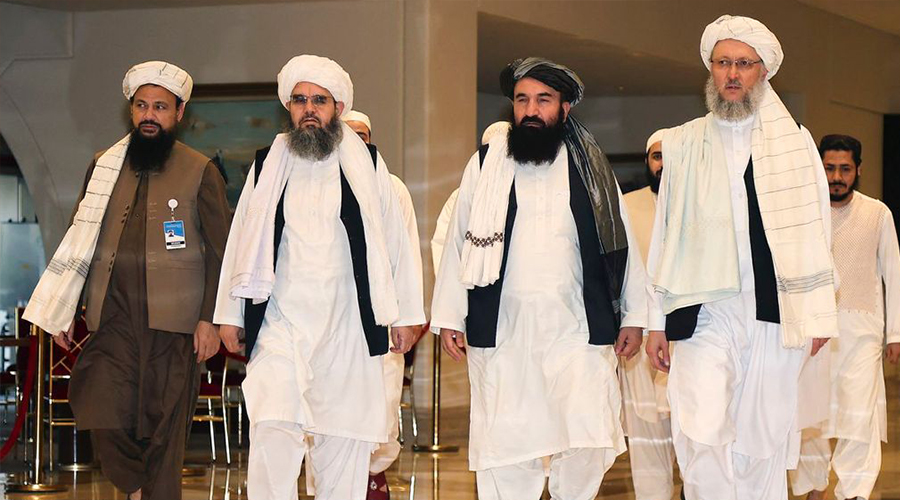The Taliban Movement did not emerge overnight in Afghanistan, and so its most recent comeback to power, following the US withdrawal from Afghanistan, did not come out of the blue. Rather, the ideology on which it is based is derived from several sources that guarantee solid and consistent organization and form a general framework for its endeavors. The movement seeks to gradually achieve multiple explicit and implicit goals. While some of these are identical to the overarching goals set by Islamist groups, others show wide-ranging differences.
Birth of the Organization
The Taliban was founded in the 1980s by Pakistan's Inter-Services Intelligence who wanted a strong organization consisting mainly of the Pashtuns to fight the Soviets who invaded Afghanistan in 1979. But the Taliban did not emerge in the Afghani arena as a militant faction until 1994, when turmoil prevailed, after the Mujahedeen entered the scene to expel the Soviets, in a grinding civil war for power and influence.
The Taliban, or "students" in the Pashto language, captured the capital Kabul in 1996 and seized power until it was overthrown in 2001 by the United States and its allies, who played a major role ironically in forming, funding and training the Taliban as part of the decades-long US-Soviet conflict known as the Cold War.
While the Taliban is predominantly Pashtun, who make up about 45 per cent of the population of Afghanistan, it comprises other small ethnic groups, such as the Tajiks, Uzbeks and Chechens.
The Taliban’s organizational structure is a hierarchy on top which sits the leader of the movement, or Amir al-Mu'minin who is currently Mullah Haibatullah Akhundzada, followed in the lower tiers by a central Shura Council, then a Higher Shura Council, a Fatwa council and then Provincial Shura Councils that have authority over military leaders.

Ideology
People operating under the banner of Taliban cling to a centuries-long religious ideology based on several sources that mixed and interacted over the years. The leaders of the movement belong to the Deobandi seminary, which was formed in the Indian town of Deoband, where the Darul Uloom Deoband, an Islamic madrassa (seminary), was established as far back as 1866 and is now known as al-Azhar of India.
The movement, which attracted students from India, Pakistan and Afghanistan, believes in pantheism, as it was influenced by ancient Hindu and Greek beliefs, and is followed by some Sufis. The Deobandi school is intellectually stagnant and rejects renewal and labels any tendency to it as idolatrous impurities and newly invented matter that has no precedent (bida’ah). The movement does not busy itself with big matters such as God, nature and man, and rather dig deep in tiny details such as banning all arts, rejecting woman’s right to work unless it is completely urgent, as well as the mandatory beard growing.
The Taliban movement’s ideology is based on the Hanafi jurisprudence and is inspired by the Jamiat Ulema-e Islam (JUI), of which the two most prominent scholars are by Samiul Haq and Fazal-ur-Rehman. The JUI was founded by prominent Sunni scholar Abu Mansur al-Maturidi, who died in 944. Because of this, the Taliban is perceived as a faction or organization that embraces Islam, believes in Maturidiyyah, a Muslim school of theology, considers its followers as part of Ahlus Sunnah Wal Jamaat, or mainstream Sunni Islam, follows the Hanafi school of jurisprudence, closely affiliated with the Ashʿari theology, while also act as Sufis. Overall, their head appears to be a Sheikh of Tariqa, or order of Islam, who has loyal followers.
This perception is rooted in the Talibans’ minds is what set them apart from other political Sunni factions and organizations such as ISIS and al-Qaeda. Al-Qaeda belongs to what is called the Salafi Jihadism. Although some Salafi-Jihadist factions formed alliances with, or sought refuge in Taliban especially after the establishment of al-Qaeda in 1998, it nonetheless views Taliban as heterodox or follower of bida’ah because it strays away from the Salafi-Jihadism that is rooted in the Khawariji ideology, as well as theories proposed in books such as Ma'alim fi-l-Tariq (Milestones) by Egyptian Islamist author Sayyid Qutb, Al-Faridha Al-Gha’ebaa (The Missing Commandment), by Mohamed Abdel Salam Faraj, al-'Umda fi I'dad al-'Udda (The Essential Guide for Preparation) and Al-Jamei’ fi Talab Al-Elam Al-Shareef (The Compendium of the Pursuit of Divine Knowledge), by Sayyid Imam Al-Sharif, better known as Dr. Fadhl, and Idarat at-Tawaḥḥush (Management of Savagery) by Abu Bakr Naji. Combined, the books form the ideological framework of ISIS.
Political Goals
In 1994, the Taliban vowed allegiance to Mulla Omar, founder of the Taliban, not only to wage Jihad against the Soviets, bring the civil war to an end, restore security and stability to Afghanistan, but also to carry out a social and religious perception. That perception is being promoted by the movement as an effective tool to combat corruption and establish an Islamic state or emirate, and represents the ‘religion of Allah’. according to Mullah Omar, who once said that the movement wants to implement the religion of Allah on this land of Allah, to serve the word of Allah and implement Shariah law and guard the limits set by Allah.
This broad headline largely sets Taliban’s goals: establishing an Islamic government, working to make Islam the religion of people and the government, enacting laws and legislations based on Sharia law to organize society, creating Sharia courts that have control on all institutions of the state, appointing capable and God-fearing scholars to lead these courts, promoting Hisbah (the need to enjoin what is right and forbid what is wrong) through bodies created for this purpose across he country. Other equally important goals include making taqwa, or God-fearing piety, the essential standard for appointing people in senior government positions; embracing Quran and Sunnah as the reference for all political, social, economic, cultural and educational matters; establishing good political relations with Islamic countries that uphold Shariah rule; promoting cooperation with Islamic societies and organizations and forming a strong and well-trained army to defend the state against greedy invaders. Social goals include combating tribal and national fanaticism, enforcing the compulsory hijab law on women, combating illegal drugs, rejecting arts, collecting zakat and spending the raised funds in Sharia-compliant banks.
Concluding Remarks
To complete this concise briefing on the formation and ideology of Taliban, the following three remarks should be made:
1- Although multiple sources of ideology are available, Taliban selected the most conservative version. Even though its ideology is a combination of Sufis and Ash'arism, it only picks all that is stagnant claiming that it is compliant with the methods of Ahlus Sunnah Wal Jamaat. Although the Hanafi school of Islamic jurisprudence accommodates difference and plurality of opinion set by founder Imam Abu Hanifa Al-Nu’man, clinging to the original time-specific jurisprudence implies an opposition of the approach that Abu Hanifa meant to promote. He knows that words or quotes change because they should serve as answers to ever-renewing questions that change according to time, circumstances and the situation and affairs of people. He was also interested in establishing methods for promoting understanding and development and not for strictly holding to certain rulings that should not change with the passage of time and change of circumstances.
2- Although some Islamic movements may not agree with the broad goals set by Taliban, a deeper insight into the details and methods of implementing the goals would reveal the fact that Taliban is no different from other movements in that each one of them acts based on the belief that it represents the right Islam and others don’t. In this regard, the movement who is just like other Islamist organizations kept fighting against numerous Islamist factions from 1994 to 1996, when it succeeded in capturing Kabul and declaring the establishment of its first Islamic emirate.
3- The enthusiasm that some Islamist organizations and groups have over Taliban’s victory in Afghanistan 20 years after it was overthrown, does not mean they identify with Taliban’s plans. That is to say, Taliban, in the eyes of political Islam groups, and the Salafi-Jihadism in particular, continues to be a different and even upholds bida’ah.
This enthusiasm, however, is due to these groups’ perception that Muslims are facing a new war waged by the West, that the US occupation of Iraq and Afghanistan represents the current episode of this war and that Taliban is fighting the war on behalf of all others. Additionally, Islamist groups saw the United States’ behavior as a clear message to the regimes that are their enemies, or that forged alliances or friendships with the United States, or are under its protection. In their view, the message also goes through to elites that these group label as westernized or act as agents of the West, and these include the Afghan elite that Washington has not protected. Most importantly, these groups viewed Taliban’s action as a source of inspiration for attempts to seize power through the use of arms.


